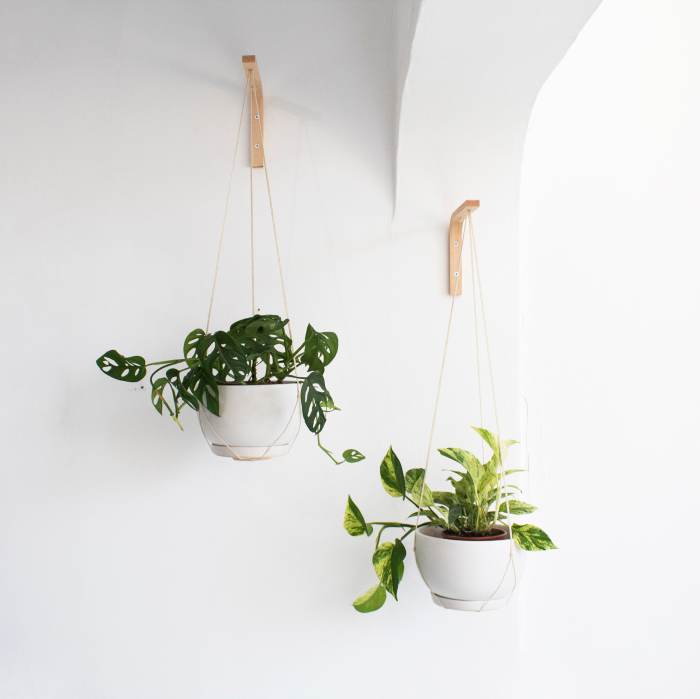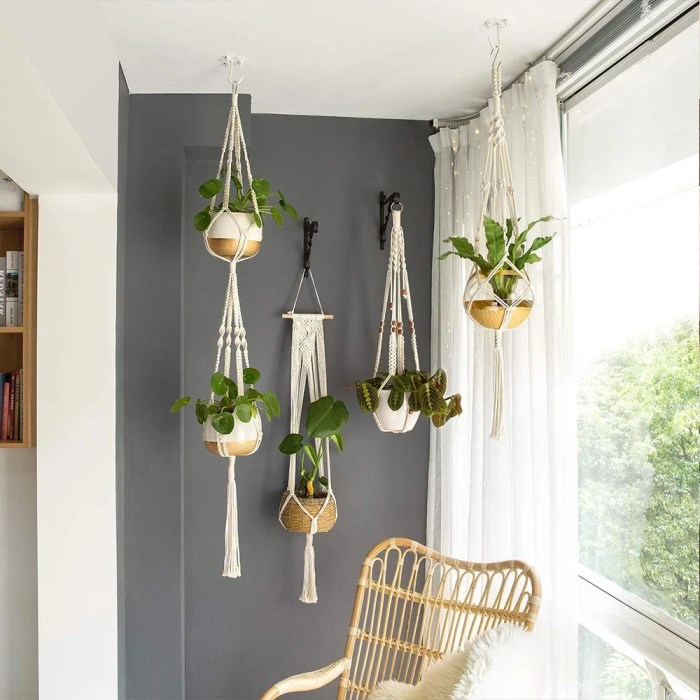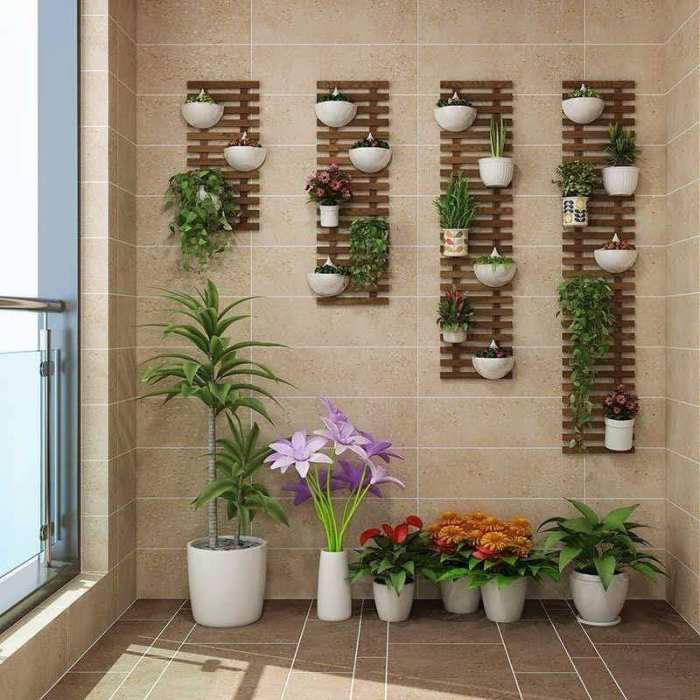As hanging plants indoor wall take center stage in modern home decor, they offer a myriad of benefits and aesthetic appeal. This comprehensive guide delves into the types, mounting techniques, creative display ideas, maintenance tips, and more, empowering you to create a lush indoor oasis with these versatile plants.
From air purification to stress reduction, hanging plants bring nature’s touch indoors, enhancing both your well-being and the ambiance of your living spaces.
Types of Hanging Plants for Indoor Walls

Hanging plants add a touch of greenery and life to indoor walls, creating a vibrant and welcoming atmosphere. They come in various shapes, sizes, and colors, offering a wide range of options to complement any décor. Here’s a comprehensive list of hanging plants suitable for indoor walls, along with their scientific names, common names, and distinctive features:
Spider Plants
- Scientific name: Chlorophytum comosum
- Common name: Spider plant
- Distinctive features: Long, arching leaves with variegated patterns, producing plantlets (baby spiders) on long stolons.
- Growth habit: Forms clumps and spreads quickly, sending out stolons that root easily.
- Light requirements: Bright indirect light or partial shade.
- Maintenance needs: Water when the soil feels dry to the touch, fertilize monthly during the growing season, and remove dead or damaged leaves.
Pothos
- Scientific name: Epipremnum aureum
- Common name: Pothos
- Distinctive features: Heart-shaped leaves with variegated patterns, including golden, green, and white.
- Growth habit: Vigorous and fast-growing, trailing or climbing.
- Light requirements: Bright indirect light or partial shade.
- Maintenance needs: Water when the soil feels slightly dry, fertilize monthly during the growing season, and prune to control growth.
String of Pearls
- Scientific name: Senecio rowleyanus
- Common name: String of pearls
- Distinctive features: Long, trailing stems with plump, bead-like leaves that resemble pearls.
- Growth habit: Trailing or cascading, forming long vines.
- Light requirements: Bright indirect light or partial shade.
- Maintenance needs: Water sparingly, allowing the soil to dry out completely between waterings, fertilize occasionally, and avoid overwatering.
Philodendron
- Scientific name: Philodendron hederaceum
- Common name: Heartleaf philodendron
- Distinctive features: Heart-shaped leaves with a glossy texture and dark green color.
- Growth habit: Climbing or trailing, with aerial roots that help it attach to surfaces.
- Light requirements: Bright indirect light or partial shade.
- Maintenance needs: Water when the top inch of soil feels dry, fertilize monthly during the growing season, and prune to control growth.
Wall-Mounting Techniques for Hanging Plants: Hanging Plants Indoor Wall
Mounting hanging plants securely on indoor walls requires careful consideration of various techniques, each with its own advantages and disadvantages. Here are some popular methods to ensure plant stability and prevent damage to walls.
Brackets
Brackets are sturdy metal or wooden supports that provide a stable base for hanging plants. They are typically installed into wall studs for maximum strength. Advantages include their durability and ability to support heavy plants. However, they require drilling and may not be suitable for all wall types.
Hooks
Hooks are a simple and versatile option for lighter plants. They come in various shapes and sizes, allowing for customization. Installation involves screwing them into the wall or using adhesive strips for temporary mounting. While convenient, hooks may not be as secure as brackets for larger plants.
Trellises
Trellises are decorative latticework structures that can be mounted on walls to support climbing plants. They provide vertical support and encourage plants to grow upwards, creating a lush and space-saving display. Trellises require careful installation and may not be suitable for all plants.
Tips for Ensuring Plant Stability
- Choose the right mounting technique for the size and weight of your plant.
- Install brackets or hooks into wall studs for maximum support.
- Use sturdy materials and ensure all fixings are tight.
- Consider using plant hangers with built-in support mechanisms.
- Regularly check the stability of the plants and make adjustments as needed.
Creative Display Ideas for Hanging Plants
Incorporating hanging plants into indoor wall decor presents endless opportunities for creativity and aesthetic appeal. Vertical gardens, macrame hangers, and innovative arrangements transform walls into living canvases, adding life and tranquility to any space.
Hanging plants indoor wall can transform any room with their lush greenery and vibrant colors. For those seeking a touch of elegance, gold wall planter indoor offer a sophisticated and eye-catching option. These planters add a luxurious accent to any wall, showcasing hanging plants indoor wall in a unique and stylish way.
Vertical Gardens
Vertical gardens are an ingenious way to maximize space while creating a lush and verdant wall display. These modular systems allow you to stack multiple planters vertically, forming a living wall that can extend from floor to ceiling or span the width of a wall.
Macrame Hangers
Macrame hangers are a bohemian and stylish way to suspend hanging plants from walls. These intricate knotted cords create an organic and artistic touch, adding texture and interest to any room. They come in various sizes and styles, allowing you to customize your display and match your decor.
Other Creative Arrangements
- Hanging Shelves:Install floating shelves on walls and place hanging plants on them, creating a tiered display with varying heights and textures.
- Wall Trellises:Attach trellises to walls and train climbing plants, such as ivy or philodendron, to grow vertically, adding a touch of greenery and privacy.
- Picture Frames:Display small hanging plants in picture frames for a unique and eye-catching wall decor idea.
Benefits of Hanging Plants Indoors
Incorporating hanging plants into indoor spaces offers a plethora of benefits that enhance both physical and mental well-being. Studies have demonstrated their ability to purify the air, reduce stress levels, and uplift mood, creating a healthier and more inviting living environment.
Air Purification, Hanging plants indoor wall
Hanging plants act as natural air purifiers, effectively removing harmful toxins and pollutants from the indoor atmosphere. Research conducted by NASA’s Clean Air Study found that certain plant species, such as spider plants, peace lilies, and snake plants, can significantly reduce levels of benzene, formaldehyde, and trichloroethylene, which are commonly found in household cleaning products and building materials.
Stress Reduction
The presence of plants indoors has been shown to have a calming effect on individuals, reducing stress levels and promoting relaxation. Studies have found that viewing or interacting with plants can lower blood pressure, heart rate, and cortisol levels, the hormone associated with stress.
The green color of plants is known to evoke feelings of tranquility and serenity.
Mood Enhancement
Hanging plants can positively impact mood and well-being. Research suggests that exposure to plants can boost serotonin and dopamine levels, neurotransmitters associated with happiness and contentment. Additionally, the act of caring for plants can provide a sense of purpose and accomplishment, contributing to overall well-being.
Maintenance and Care for Indoor Hanging Plants

Indoor hanging plants bring a touch of nature and elegance to your home, but they require proper care to thrive. Here’s a comprehensive guide to ensure your hanging plants stay healthy and vibrant:
Watering:Hanging plants can dry out more quickly than traditional potted plants due to increased air circulation. Water thoroughly when the soil feels dry to the touch, but avoid overwatering, which can lead to root rot. Use a watering can with a narrow spout to direct water precisely to the soil, avoiding the leaves.
Hanging plants indoor wall is a popular trend for decorating homes and adding a touch of nature to living spaces. One popular way to display hanging plants is by using macrame plant hangers indoor. Macrame plant hangers are a type of hanger made from knotted cords or ropes, and they add a bohemian and stylish touch to any room.
Whether you choose to hang plants from the ceiling, a wall, or a shelf, macrame plant hangers indoor are a versatile and attractive way to showcase your greenery.
Fertilization:Fertilize your hanging plants monthly during the growing season (spring and summer) with a balanced liquid fertilizer. Follow the instructions on the fertilizer label for proper dilution and application.
Pruning:Pruning encourages new growth and maintains the desired shape of your hanging plants. Use sharp, clean shears to remove dead or damaged leaves and stems. Trim back overgrown vines to control their length and promote bushier growth.
Common Pests and Diseases
Hanging plants are susceptible to common pests and diseases, including aphids, mealybugs, and powdery mildew. Inspect your plants regularly for signs of infestation or disease, and take prompt action to prevent spread.
Aphids:These tiny, green insects feed on plant sap, causing stunted growth and yellowing leaves. Use insecticidal soap or neem oil to control aphids.
Mealybugs:These white, cottony insects attach themselves to plant stems and leaves, sucking out their nutrients. Remove mealybugs manually with a cotton swab dipped in rubbing alcohol or use a systemic insecticide.
Powdery Mildew:This fungal disease appears as a white, powdery substance on leaves. Treat powdery mildew with a fungicide or a mixture of baking soda and water.
Hanging plants indoor wall is a great way to add some greenery to your home. They can be used to create a living wall, or simply to add a touch of nature to a room. If you’re looking for a way to add some extra style to your hanging plants, consider using a corner wall planter indoor . These planters are designed to fit snugly into a corner, and they can be used to create a dramatic display of your plants.
Whether you’re looking for a way to add some greenery to your home or you’re just looking for a new way to display your plants, hanging plants indoor wall is a great option.
Monitoring Plant Health
Regularly monitor your hanging plants for signs of distress. Wilting, yellowing leaves, and stunted growth can indicate problems with watering, fertilization, or pest infestation. Check the soil moisture, inspect for pests, and adjust your care routine accordingly.
Last Word

Whether you seek to create a verdant vertical garden or add a touch of greenery to a cozy corner, hanging plants indoor wall offer endless possibilities. Embrace the beauty and benefits of these botanical wonders and transform your home into a sanctuary of tranquility and style.
Questions and Answers
What are the best hanging plants for indoor walls?
Some popular options include pothos, spider plants, philodendrons, and ferns, which are known for their adaptability and low maintenance needs.
How do I securely mount hanging plants on indoor walls?
You can use brackets, hooks, or trellises, ensuring they are securely attached to the wall and can support the weight of the plant and its pot.
How often should I water hanging plants?
Watering frequency depends on the plant species, but generally, water when the top inch of soil feels dry to the touch.